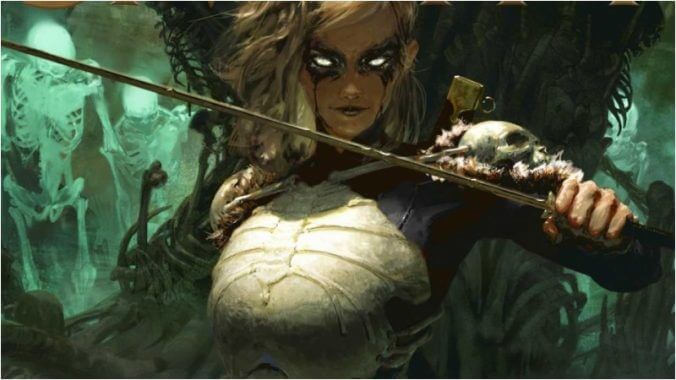Magic In Iron and Bone In Nicki Pau Preto’s Bonesmith

Readers familiar with Nicki Pau Preto’s Crown of Feathers trilogy might be surprised to find that the cover for her new novel, Bonesmith, is dominated by black and white tones, with green spirits looming behind. But for Pau Preto’s brand new world, the monochrome hues make sense. The Dominions are a cold land, where magic is drawn from the materials of the land itself—including the bones of those who died there.
Wren is among the best of the young bonesmiths training to serve as valkyr, the warriors who defend reapyrs who send the spirits of the dead to their afterlives. It’s too bad that someone’s out to make sure she fails. Ousted from the bonesmith hierarchy after “failing” her career-breaking test, Wren is sent into exile, to serve in a fort on the edge of the Dominion lands. There, the Wall separates civilization from the Breachlands, a territory overrun by undead, where Wren’s lauded uncle, the former heir to the House of Bone, fell in battle.
But as Wren takes on her position at the fort, becoming friends with the Dominion prince, she begins to realize that the history she’s always been told has left out some very important details. When Prince Leo is kidnapped by a team that includes a supposedly-extinct ironsmith, Wren’s determined to go after him, saving him and restoring her honor. But the ironsmith, Julian, becomes her only ally across the Wall, and the truths taught in the Breachlands don’t match up with Wren’s understanding of the world. To survive, she has to trust a hated enemy—and confront evidence that her own House’s stakes in the world are very different than anyone ever realized.
Though the atmosphere is black and white—black represents iron magic and white, bone—the moral complications are anything but. Pau Preto does a fantastic job building a growing sense of unease as secret after secret is uncovered. She manages this despite her brash and prickly point of view character—who looms gloriously large over the narrative, her arrogance never fully checked, even when her ego is bruised. In a chat with Paste about the book, Pau Preto confesses, “I definitely knew Wren would be polarizing, but I also think there’s something so authentic about her that I find incredibly appealing.”
Despite her big personality, Pau Preto never had a problem wrangling Wren in the narration. “I think it’s because she has such strongly defined goals and motivations, she knows who she is (or thinks she does anyway) and what she wants,” she says. “I never had to waffle over what she’d do, because it always felt very clear to me—but that was thanks to the work I did up front.”
Pau Preto was surprised by the chemistry that Wren instantly had with Prince Leo—not necessarily the romantic kind (although perhaps readers have yet to see where that might go), but definitely in their instant friendship. Both Wren and Leo are natural born troublemakers, ready to push boundaries to see what they can accomplish. Leo’s shallow exterior belies clever inner manipulations, as Leo, also a goldsmith, turns difficult situations from lead into gold. Because so much of the narration is tight to Wren’s perspective, readers only get glimpses into Leo’s thoughts, but those small hints flesh out the book far beyond what a first person narrative would have allowed.
“My previous series was also third-person, but it featured alternating point-of-view chapters, with up to six POV characters by the end of the trilogy,” Pau Preto says. “It makes for sprawling storytelling, but you do lose time with your main character, and it can really slow the pacing. So I knew from the jump that I wanted Bonesmith to be more streamlined and intimate, but of course, there are some things that you can’t really achieve if you stick to a single narrator. Not only does switching POVs allow the reader to see certain people and places first-hand, enriching the story, it also helps me get to know my characters better.”
-

-

-

-

- Curated Home Page Articles By Test Admin October 21, 2025 | 3:10pm
-

- Curated Home Page Articles By Test Admin October 21, 2025 | 2:57pm
- Urls By Test Admin October 21, 2025 | 2:57pm
- Curated Home Page Articles By Test Admin October 21, 2025 | 2:55pm
-

-

-

-

-

-

-

-

-

-

-

-

-

-

-

-

-

-

-

-

-

-

-

-

-

-

-

-

-

-

-




































